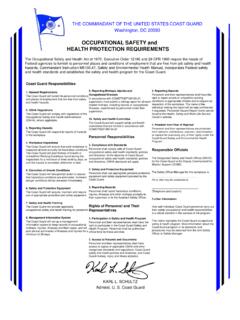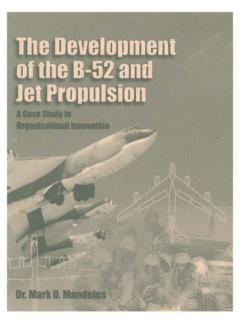Transcription of THE 5G ECOSYSTEM: RISKS & OPPORTUNITIES FOR DoD
1 the 5g ecosystem : RISKS & OPPORTUNITIES FOR DoD DEFENSE INNOVATION BOARD April 2019 the 5g ecosystem : RISKS & OPPORTUNITIES for DoD Defense Innovation Board, 3 April 2019 Coauthors: Milo Medin and Gilman Louie DIB 5G Study Preliminary Release, 3 April 2019 1 TABLE OF CONTENTS Executive Summary 2 CHAPTER 1: 5G HISTORY AND OVERVIEW 5 A History of Generation Technology 5 History s Lessons: First-Mover Advantage in Generation Transitions 6 Spectrum Use and Options 8 Millimeter Wave (mmWave) 8 Sub-6 10 CHAPTER 2: CURRENT STATE OF THE 5G COMPETITIVE FIELD 12 China 12 South Korea 13 Japan 14 Rest of World (Non-US) 15 United States 16 Private Sector 16 Public Sector: White House 18 Public Sector: FCC 18 Public Sector: Department of Commerce 19 CHAPTER 3: DoD DEVELOPMENT AND ADOPTION OF 5G TECHNOLOGY 21 5G Impact on DoD 21 Pivot to Sub-6 GHz 21 A Path Forward for Sub-6 Spectrum Sharing 22 Security Challenges in 5G 23 supply chain RISKS 23 5G Infrastructure and Services 24 5G Devices 25 CHAPTER 4: BOARD RECOMMENDATIONS FOR 5G 27 Board Recommendations 27 Recommendation #1 27 Recommendation #2 28 Recommendation #3 30 Recommendation #4 31 DIB 5G Study Preliminary Release, 3 April 2019 2 Executive Summary The term 5G refers to the oncoming fifth generation of wireless networks and technology that will produce a step-change improvement in data speed, volume, and latency (delay in data transfer) over fourth generation (4G and 4G LTE) networks.
2 5G will enable a host of new technologies that will change the standard of public and private sector operations, from autonomous vehicles to smart cities, virtual reality, and battle networks. Historical shifts between wireless generations suggest that the first-mover country stands to gain billions in revenue accompanied by substantial job creation and leadership in technology innovation. First movers also set standards and practices that were then adopted by subsequent entrants. Conversely, countries that fell behind in previous wireless generation shifts were obligated to adopt the standards, technologies, and architectures of the leading country and missed out on a generation of wireless capabilities and market potential. In the early 2010 s, AT&T and Verizon rapidly deployed LTE across the United States on the 700 Megahertz (MHz) spectrum they won at auction in 2008. Building on this deployment, the United States became the first country (after Finland) to see a comprehensive LTE network that delivered approximate 10x the consumer network performance of then-existing 3G networks.
3 This step-change in performance drove rapid adoption of new handsets with new semiconductors that not only could move much more data, but were also computationally much faster. companies like Apple, Google, Facebook, Amazon, Netflix, and countless others built new applications and services that took advantage of that bandwidth. As LTE was deployed in other countries, those same handsets and applications spread across the world. This initiative helped drive global dominance in wireless and internet services, and created a wireless ecosystem on which the Department of Defense (DoD) and the rest of the world has operated for nearly a decade. Since the rollout of LTE, these wireless competitive landscape has undergone many changes. Chinese telecommunications equipment giant Huawei grew global revenues from approximately $28B in 2009 to $107B in 2018, while other traditional market leaders like Ericsson and Nokia have declined in revenue over that same period.
4 Chinese handset vendors like Huawei, ZTE, Xiaomi, Vivo, and Oppo have rapidly grown in global market share, and are still growing rapidly in adoption and influence despite minimal sales in the market. In 2009, all of the top 10 Internet companies by revenue were American. Today, four of the top 10 are Chinese. These trends are already in effect, and 5G has the potential to skew future networks even further in the direction of China if it continues to lead. The shift from 4G to 5G will drastically impact the future of global communication networks and fundamentally change the environment in which DoD operates. While DoD will feel the impact of 5G, the rollout itself will be driven by the commercial sector. This study provides insight into the commercial landscape as well as the DoD landscape to give a comprehensive view of the stakeholders and future of 5G. 5G has the ability to enhance DoD decision-making and strategic capabilities from the enterprise network to the tactical edge of the battlefield.
5 5G will increase DoD s ability to link DIB 5G Study Preliminary Release, 3 April 2019 3 multiple systems into a broader network while sharing information in real time, improving communication across Services, geographies, and domains while developing a common picture of the battlefield to improve situational awareness. This improved connectivity may in turn enable a host of new technologies and missions, from hypersonics and hypersonic defense to resilient satellite constellations and mesh networks. Spectrum will play a key role in the operation, development and roll-out of 5G. Peak data rates are driven by the amount of spectrum that is available to a wireless service. In 4G, up to five 20 MHz channels can be bonded together. But in 5G, up to five 100 MHz channels can be bonded together, enabling speeds approximately 20x faster than 4G and 4G LTE. While some 5G technology will be deployed in the currently-used cellular spectrum and achieve modest gains in performance (LTE is already fairly well optimized), full 5G development will require significantly more spectrum to provide another step-change improvement in performance for consumers, DoD or otherwise.
6 Countries are pursuing two separate approaches to deploy hundreds of MHz of new spectrum for 5G. The first focuses on the part of the electromagnetic (EM) spectrum below 6 GHz ( Low- to Mid-Band Spectrum, also referred to as sub-6 ), primarily in the 3 and 4 GHz bands. The second approach focuses on the part of the spectrum between ~24 and 300 GHz ( High-Band Spectrum, or mmWave ), and is the approach taken by the United States, South Korea, and Japan (although all three countries are also exploring sub-6 to various degrees). carriers are primarily focused on mmWave deployment for 5G because most of the 3 and 4 GHz spectrum being used by the rest of the world for 5G are exclusive Federal bands in the United States, extensively used by DoD in particular. The question of spectrum allocation is at the heart of the 5G competition, for the spectrum band of choice, whether sub-6 or mmWave, impacts nearly every other aspect of 5G development. Spectrum bands in the 3 and 4 Ghz range dominate global 5G activity because of improved propagation (range) over mmWave spectrum, resulting in far fewer base stations needed to be deployed to deliver the same coverage and performance.
7 Because large swaths of the sub-6 bands in the United States are not available for civil/commercial use, carriers and the FCC (which controls civil spectrum in the US) are betting on mmWave spectrum as the core domestic 5G approach. carriers may continue to pursue mmWave, but it is impossible to lead in the 5G field without followers. Leadership in wireless networks requires the global market to subscribe to DIB 5G Study Preliminary Release, 3 April 2019 4 and build to the specifications of the leader s spectrum bands of choice, as these 5G subcomponents and products will ultimately drive interoperability across networks. The rest of the world does not face the same sub-6 spectrum limitations as carriers, and is subsequently pursuing 5G development in that range. As a result, the United States may find itself without a global supply base if it continues to pursue a spectrum range divergent from the rest of the world. If the future 5G ecosystem adopted by most of the world is built on the sub-6 mid-band spectrum, the United States will also be faced with mmWave device interoperability challenges and sub-6 infrastructure security concerns.
8 As sub-6 becomes the global standard, it is likely that China, the current leader in that space, will lead the charge. This would create security RISKS for DoD operations overseas that rely on networks with Chinese components in the supply chain . Even if the United States were to restrict use of Chinese equipment suppliers domestically, the United States is not a big enough market in wireless to prevent China s 5G suppliers from continuing to increase market share globally, resulting in significant pressure on a declining set of vendors that would serve the market. These vendors will in turn be unable to invest R&D towards future 5G offerings due to decreasing market share, limiting the number of competitive products and depriving DoD and industries of better and cheaper global supply chains. China plans to deploy the first widespread 5G network , with its first set of sub-6 services becoming available in 2020. First-mover advantage will likely drive significant increases in their handset and telecom equipment vendors market along with their domestic semiconductor and system suppliers.
9 As a result, Chinese internet companies will be well-positioned to develop services and applications for their home market that take advantage of 5G speed and low latency. As 5G is deployed across the globe in similar bands of spectrum, China s handset and internet applications and services are likely to become dominant, even if they are excluded from the US. China is on a track to repeat in 5G what happened with the United States in 4G. DIB 5G Study Preliminary Release, 3 April 2019 5 CHAPTER 1: 5G HISTORY AND OVERVIEW A History of Generation Technology Mobile wireless technology has been in development for decades, with the first generation (1G) introduced in the late 1970s and fielded in the early 1980s. Since then, new generations of technology and wireless standards have been introduced every decade or so, culminating in our present state of transition between 4G and 5G capabilities. The value of each generation has increased exponentially, as each has enabled a host of other technology advancements across the commercial sector and military.
10 All existing generations work within the low- to mid-band spectrum (less than 6 GHz, or sub-6), but 5G has opened the door for millimeter wave (mmWave) spectrum use as well. 1G (Voice Calls): 1G mobile networks were fielded in the early 1980s with voice communications and limited emphasis on data transfer capability (early capability ~ Kbps). 1G networks utilized analog signals to hand off cell users between a network of distributed base stations (hosted on cell towers) using standards like AMPS and TACS. Source: 2G (Messaging): In the 1990s, 2G mobile networks spawned the first digitally-encrypted telecommunications that improved voice quality, data security, and data capacity, while hosting limited data capability by way of circuit-switching using the GSM standard. In the late 1990s, and technology brought about improved data rates (upwards of 200 Kbps) using GPRS and EDGE standards, respectively. These later 2G iterations introduced data transmission via packet-switching, which served as a stepping-stone to 3G technology.










